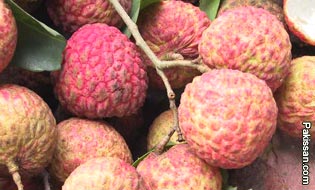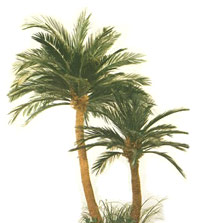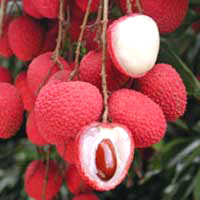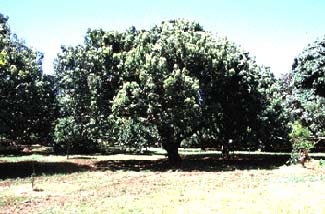|
Growing lychee trees
under datepalm in Khairpur
By Shaukat Ali Bhambhro
The predominant fruit crop of Khairpur district in upper Sindh
is date-palm. According to a conservative estimate, around
100,000 acre of district land is under date-palm cultivation.
Recently, a new trend, of growing different crops and fruit
trees under the canopy of date-palm, has been observed, and
the reason behind these inter-croppings gaining popularity is
lucrative returns.
 Climatically,
Khairpur district is sub-arid to arid. Its eastern part is
comprised of vast Nara desert. The western part of the
district is irrigated by three irrigation canals which take
off from Sukkur barrage. After the devastation of banana
plantation following the spread of banana bunchy top disease (BBTD)
growing banana under date-palm is no more considered
cost-effective. Instead mango plantation with date-palm is
quite common in spite of the fact that mango trees under the
canopy of date-palm are vulnerable to many diseases and pests
especially malformation and mildews. Climatically,
Khairpur district is sub-arid to arid. Its eastern part is
comprised of vast Nara desert. The western part of the
district is irrigated by three irrigation canals which take
off from Sukkur barrage. After the devastation of banana
plantation following the spread of banana bunchy top disease (BBTD)
growing banana under date-palm is no more considered
cost-effective. Instead mango plantation with date-palm is
quite common in spite of the fact that mango trees under the
canopy of date-palm are vulnerable to many diseases and pests
especially malformation and mildews.
However, a prudent grower of Khairpur after losing his banana
plantation under date-palm orchard following the BBTD attack
attempted cultivation of lychee fruit trees under the canopy
of about 30-year-old date-palms. About 40 grafted lychee
plants were planted between the date-palm trees which were 30
feet apart. The growth of the plants was very slow.
According to this grower, being unaware of its requirement of
irrigation and fertilizer, no
 special
care was taken even of plant protection. As a matter of fact,
irrigation and fertilizer applied to date-palm were also meant
for thevery lychee plants. But to his surprise, the lychee
plants gave fruit this yearafter attaining four years of age.
With the present rate of growth, it appears that after 10
years these plants may assume the shape of trees. special
care was taken even of plant protection. As a matter of fact,
irrigation and fertilizer applied to date-palm were also meant
for thevery lychee plants. But to his surprise, the lychee
plants gave fruit this yearafter attaining four years of age.
With the present rate of growth, it appears that after 10
years these plants may assume the shape of trees.
A review has revealed that lychee is a long-lived tree.
Although if we do not consider the references in Chinese
literature to 800-year-old trees as accurate, it seems
probable that trees may remain in profitable bearing for more
than a century. Under the unusual conditions prevailing in
Baglore in South India, the lychee is said to bear two crops a
year, in May and December.
One of the reasons behind cultivating lychee under date-palm
is to protect lychee trees from the desiccating wind in drier
regions. Besides, the review of literature also indicates that
the lychee grows well under a variety of soil conditions, but
seems to prefer a fairly deep loamy alluvial soil. Although it
cannot tolerate water logging, it favours moist soil as the
roots form the mycorhyzae rapidly in soggy environment.
Because lychee is rather shallow rooted, deep tillage is
dangerous. Therefore, ploughing in lychee orchard is not
recommended and for the same reason use of mulch is suggested.
According to one Indian horticulturist, the lime content of
the best lychee region of Bihar is high, about 30 per cent,
and he suggests that in region where lime is deficient, it may
be desirable to add it to the soil.
Roy (1952) also recommends the use of lime and sugar where its
deficiency is marked, as the tree responds clearly to its
application.This may be desirable only where very little
calcium is present, as is suggested by the fact that lychee
has failed on the alkaline soil of Israel.
In South Africa, lychee trees make much more vigorous growth
on acid soil than on
 neutral
or slightly alkaline soil. To assure the presence of the
mycorhyzal fungi, the use of soil from under the old trees for
propagating new ones, it would seem, however, that the lychee
is probably capable of growing well on either acidor basic
soil. The Chinese are said to believe that the nature of the
soil has a marked influence on the quality of the fruit yield.
Only a small percentage of the flowers develop into fruits.
Failure in producing and the drop of many of the fruits during
the first month may be caused by the lack of fertilization or
embryo abortion resulting from the chromosome irregularities. neutral
or slightly alkaline soil. To assure the presence of the
mycorhyzal fungi, the use of soil from under the old trees for
propagating new ones, it would seem, however, that the lychee
is probably capable of growing well on either acidor basic
soil. The Chinese are said to believe that the nature of the
soil has a marked influence on the quality of the fruit yield.
Only a small percentage of the flowers develop into fruits.
Failure in producing and the drop of many of the fruits during
the first month may be caused by the lack of fertilization or
embryo abortion resulting from the chromosome irregularities.
After these trees come into bearing, the yield should increase
for at least 20 years. Under favourable conditions, the lychee
bears heavily and regularly. Although Stephens (1935) states
that in Queensland a crop is borne only once in two or three
years. He indicates that on an average crop is about 200 to
300 lb per tree.
Lychee is a fruit of lychee chinensis (family: Sapeindaceae)
consisting of thin, brittle shell enclosing a sweet, jelly
like pulp and a single seed. The original home of lychee is in
China. India probably is second in production of lychee where
only in North Bihar the total area under cultivation of this
seasonal fruit is reportedly 26,000 hectares.
According to a recent survey report of a senior scientist of
the Indian Institute of Horticulture Research, Banglore litchi
grown over one acre of land in Muzafferpur (Bihar) can be sold
at a minimum price of Rs100,000 in the UK.The very agriculture
scientist has claimedin her comprehensive report that being
the costliest fruit in the world, fresh lychee is sold at the
rate of Rs500 to Rs12,00 per kgin different parts of the
globe.
The lychee has had a long and honorable history in China where
it has been carefully
 cultivated
and greatly appreciated for many centuries. The first
reference to this fruit in literature may be as early as 1760
BC., but this is a questionable. Apparently, the lychee
reached Burma and eastern India by the end of the 17thcentury
or shortly thereafter. Lychee plants are medium to large, much
branched, round-topped and evergreen reachingup to 12 -15
meters, leaves pinnately compound. The inflorescence is a
compound raceme, bears small , off-white unisexual and
bisexual flowers. The fruit develops into bunches and varies
in shape and size. The lychee plants require warm, humid
climate for vegetative growth. Dry hot air is injurious for
the fruit. cultivated
and greatly appreciated for many centuries. The first
reference to this fruit in literature may be as early as 1760
BC., but this is a questionable. Apparently, the lychee
reached Burma and eastern India by the end of the 17thcentury
or shortly thereafter. Lychee plants are medium to large, much
branched, round-topped and evergreen reachingup to 12 -15
meters, leaves pinnately compound. The inflorescence is a
compound raceme, bears small , off-white unisexual and
bisexual flowers. The fruit develops into bunches and varies
in shape and size. The lychee plants require warm, humid
climate for vegetative growth. Dry hot air is injurious for
the fruit.
The edible portion (50-75 per cent of fruit weight of litchi
contains mainly carbohydrate (sugar), protein, fat, vitamin (B
and C), calcium and iron.
After a successful cultivation of litchi under date palm
orchards in District Khairpur it is suggested that necessary
arrangements for large scale promotion of this fruit crop are
required to be made by the horticulture division of PARC
Islamabad.
Source: The DAWN
|
Pakissan.com;
|